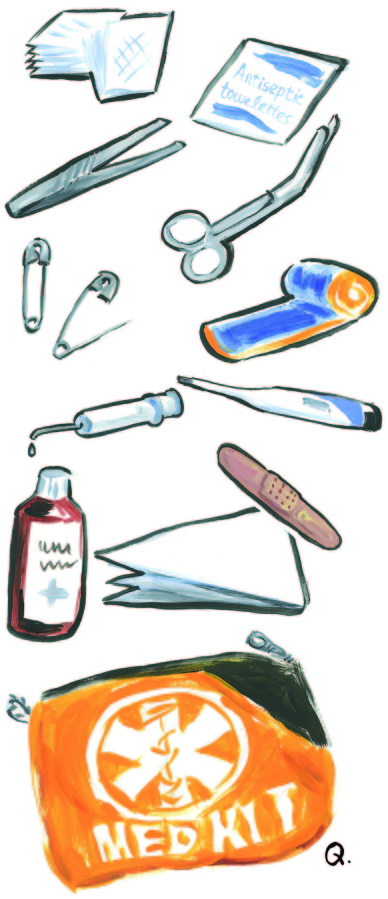SPOKANE — With spring well-established and summer outdoor adventures fast approaching, it’s time to consider your first-aid kit.
What’s in it? What’s not? What should be? Do you have one?
To some extent experts differ on the particulars, but there is one thing everyone can agree on: Consider the activity.
“What are the common and then worst-case scenario problems that happen with those activities? Then build or buy a kit that addresses both those issues,” said Jason Luthy, the founder of Sandpoint, Idaho-based Longleaf Wilderness Medicine.
For instance, if you’re hunting or around guns, make sure you have materials that can stop bad bleeds fast. Ditto for chainsaw or handsaw work. That could include QuikClot, a tourniquet, bandages or sutures (if you know how to use them).
Of course, big bleeds can happen while hiking, too. A basic backpacking first-aid kit should also have some trauma care gear.
“Most people end up getting a really small first-aid kit because they don’t want to carry a bunch (of stuff),” Luthy said. “Typically, it is trauma care I see people lacking mostly.”
Luthy also recommends recreationists pack basic survival gear (fire starter, extra food, maybe an emergency blanket) into day-trip first-aid kits. If you have prescription medications that must be taken, consider packing some extra in your day pack’s first-aid kit in case you have “an unanticipated night out.”
The second point experts emphasized is you need to know how to use whatever you have.
Paul Holle, a National Outdoor Leadership School wilderness medicine instructor, recalled buying a first-aid kit off Amazon. When he unpacked it he found, among many things, a needle decompression kit. Needle decompression is used to relive acute pressure in the rib area by sticking a large needle into the patient’s chest.
In other words, it’s an advanced skill and one most folks with some basic emergency medicine background don’t know how to do safely.
Or as Luthy said, “Training is the lightest thing you can carry.”
For most outdoor recreationists, buying a premade kit is likely the best and cheapest way to go. Once you’ve gathered your gear, go through it and adapt it to your particular needs.
Make sure to refill your kit and check the expiration dates on any medicine.
Todd Dunfield, a longtime Washington Trails Association volunteer, said he has multiple first-aid kits, each built around specific activities.
“I find that having first-aid kits tucked away and left in places instead of having one or two that I shuffle around works better for me,” he said. “This is excessive, but these are the first-aid kits I keep packed and don’t move, cut into or steal goodies out of.”
Which highlights perhaps the most important point of all. You have to have your first-aid kit handy. Otherwise, what’s the point?
“Just carry it,” Luthy said. “Unfortunately, the kit is needed when you don’t anticipate that it’s needed.”
Here are some things to consider when buying, building or retrofitting your first-aid kit. The list of items is pulled from a recommended list published by NOLS, one of the leading wilderness medicine providers in the world. It’s been broken into categories for ease of use.
Wound care
A big, bad bloody wound. This can be life-threatening, or just painful (hello, blisters). Either way, here are some things to consider:
- Trauma shears
- Gloves
- Fabric bandages
- Gauze pads
- Irrigation syringe for cleaning wounds
- Wound-closure strips
- Blister dressings (moleskin)
- Triangular bandages (cravats)
- Tourniquet and/or QuikClot
- Tampons (good for nose bleeds, etc.)
Musculoskeletal injuries
Think twisted ankles or broken bones. Not fun.
- Splint
- Tape (for ankles, also just generally useful)
- Coban wrap (it’s that sticky brown tape; I had to Google it)
Medication and wound care
For inflammation, fever, cleanliness, etc.
- Antibiotic ointment packets
- Povidone-iodine (skin disinfection solution)
- Acetaminophen (think Tylenol; helps with minor aches and pains)
- Ibuprofen
- Diphenhydramine (think Benadryl)
- Antiseptic towelettes
Miscellaneous
Other items that, depending on trip and preferences, you may consider adding.
- Mask (COVID-19)
- CPR mask
- Safety pins
- Tweezers
- Basic wilderness first-aid pocket guide
- Thermometer
Where to buy
The experts agree, the particular brand of first-aid kit doesn’t matter as much as the contents.
REI sells multiple first-aid kit options, as do other sporting goods stores.
Among the many online options consider the National Outdoor Leadership Schools first-aid kits at store.nols.edu/. They have several first-aid kit options, ranging from small individual kits to multiday, multiperson kits.



